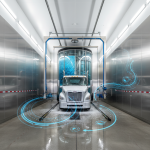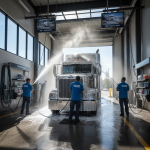In today’s fast-paced world, customer satisfaction has become a top priority for businesses. Every aspect of the customer experience matters, from the quality of the product to the efficiency of the delivery process. However, one often overlooked factor that can have a significant impact on customer satisfaction is the cleanliness of the delivery vehicles.
When a customer receives a package delivered by a dirty vehicle, it can create a negative impression of the company. It gives the perception that the business lacks attention to detail and professionalism. This can in turn affect customer loyalty and overall satisfaction.
Furthermore, dirty delivery vehicles can also contribute to environmental concerns. As these vehicles release emissions and pollutants into the air, it not only impacts the overall air quality but also has long-term effects on the environment.
In order to enhance customer satisfaction and promote a positive brand image, businesses need to prioritize the cleanliness of their delivery vehicles. Regular maintenance and cleaning can go a long way in ensuring customer happiness and loyalty. By investing in clean and well-maintained vehicles, businesses can not only improve customer satisfaction but also contribute to a healthier and more sustainable environment.
Why cleanliness of delivery vehicles is important for customer satisfaction
The cleanliness of delivery vehicles plays a crucial role in ensuring customer satisfaction. When a customer receives a package, the first thing they see is the delivery vehicle. If the vehicle is dirty or unkempt, it creates a negative impression of the company and its commitment to quality. Customers may question the hygiene standards of the company and feel hesitant about using their services again in the future.
Moreover, a dirty delivery vehicle can also impact the overall experience of receiving a package. Customers expect their purchases to arrive in pristine condition, and a dirty vehicle can cast doubts on the integrity of the products inside. Customers may worry that the items have been mishandled or damaged during transit, leading to disappointment and frustration.
In addition, the cleanliness of delivery vehicles can also affect the perception of the company’s professionalism. A dirty vehicle may give the impression that the company lacks attention to detail and fails to prioritize customer satisfaction. This can erode trust and confidence in the brand, ultimately leading to a decline in customer loyalty.
The role of cleanliness in maintaining brand image and reputation
A company’s brand image and reputation are vital in today’s competitive market. A dirty delivery vehicle can tarnish the brand’s image and reputation, making it difficult to attract new customers and retain existing ones. Customers associate cleanliness with professionalism, reliability, and attention to detail. Therefore, a dirty vehicle sends the message that the company does not prioritize these qualities.
Furthermore, in the age of social media and online reviews, one negative experience can quickly spread and impact a company’s reputation. Customers who receive packages from dirty vehicles may share their disappointment on social media platforms or leave negative reviews, further damaging the brand’s image. It is crucial for businesses to understand that every interaction, including the delivery process, contributes to the overall perception of the brand.
The psychological impact of dirty delivery vehicles on customers
The cleanliness of delivery vehicles can have a significant psychological impact on customers. Research has shown that cleanliness plays a vital role in human psychology, influencing emotions, perceptions, and behavior. When customers receive a package from a dirty vehicle, it can evoke negative emotions such as disgust, frustration, and disappointment.
These negative emotions can create a lasting impression and affect customer satisfaction. Customers may associate these negative emotions with the brand, leading to a decline in loyalty and a reluctance to engage with the company in the future.
Moreover, cleanliness also influences the perception of product quality. Customers may question whether a company that neglects the cleanliness of its delivery vehicles also neglects the quality of its products. This can lead to a decrease in trust and willingness to make future purchases.
Case studies showcasing the negative effects of dirty delivery vehicles on customer satisfaction
Several case studies have highlighted the negative effects of dirty delivery vehicles on customer satisfaction. In one study conducted by a leading e-commerce company, customers were asked to rate their satisfaction with the delivery process. The study found that customers who received packages from clean vehicles reported higher levels of satisfaction compared to those who received packages from dirty vehicles.
Another case study focused on the impact of vehicle cleanliness on customer loyalty. The study analyzed customer feedback and found that customers who received packages from clean vehicles were more likely to recommend the company to others and make repeat purchases. On the other hand, customers who received packages from dirty vehicles were less likely to engage with the company in the future.
These case studies highlight the importance of vehicle cleanliness in driving customer satisfaction and loyalty. They emphasize the need for businesses to prioritize the cleanliness of their delivery vehicles to maintain a positive brand image and enhance customer experiences.
The financial implications of ignoring vehicle cleanliness
Ignoring vehicle cleanliness can have significant financial implications for businesses. As mentioned earlier, a dirty delivery vehicle can create a negative impression of the company, leading to a decline in customer loyalty and satisfaction. This, in turn, can result in a decrease in sales and revenue.
Moreover, negative reviews and social media posts about dirty delivery vehicles can further harm the company’s reputation, making it difficult to attract new customers. Negative word-of-mouth can spread quickly in today’s digital age, and businesses may find it challenging to recover from the damage caused by a poor delivery experience.
On the other hand, investing in clean delivery vehicles can have a positive impact on the company’s bottom line. Customers who receive packages from clean vehicles are more likely to recommend the company to others, leading to increased referrals and new customer acquisition. Additionally, satisfied customers are more likely to make repeat purchases, resulting in higher customer lifetime value and increased revenue.
Best practices for maintaining clean delivery vehicles
Maintaining clean delivery vehicles requires a combination of regular cleaning and proper maintenance. Here are some best practices that businesses can follow to ensure the cleanliness of their vehicles:
1. Implementing regular vehicle cleaning and maintenance schedules: Establish a schedule for regular vehicle cleaning, including both interior and exterior cleaning. This can help prevent dirt and grime from accumulating and ensure that the vehicles always appear clean and presentable.
2. Training delivery personnel on the importance of vehicle cleanliness: Provide training to delivery personnel on the importance of maintaining clean vehicles. Emphasize the impact of vehicle cleanliness on customer satisfaction and the overall brand image. Encourage personnel to take pride in their vehicles and treat them with care.
3. Conducting regular inspections: Regularly inspect the vehicles to identify any cleanliness issues or damages. Promptly address any issues to ensure that the vehicles are always in optimal condition.
4. Using eco-friendly cleaning products: Consider using eco-friendly cleaning products to minimize the environmental impact of vehicle cleaning. This aligns with the growing consumer demand for sustainable practices and demonstrates the company’s commitment to environmental responsibility.
By following these best practices, businesses can maintain clean delivery vehicles and enhance customer satisfaction. Clean vehicles contribute to a positive brand image, improve customer loyalty, and ultimately drive business growth.
Implementing regular vehicle cleaning and maintenance schedules
In today’s competitive business landscape, customer satisfaction is paramount. Every touchpoint with the customer, including the delivery process, contributes to their overall experience. Cleanliness of delivery vehicles plays a crucial role in ensuring customer satisfaction and maintaining a positive brand image.
Dirty delivery vehicles can create a negative impression of the company, impacting customer loyalty and overall satisfaction. It also has financial implications, as negative experiences can lead to decreased sales and revenue. On the other hand, investing in clean vehicles can result in higher customer satisfaction, increased customer loyalty, and improved financial performance.
By implementing best practices for maintaining clean delivery vehicles, businesses can enhance customer satisfaction, promote a positive brand image, and contribute to a healthier and more sustainable environment. Prioritizing vehicle cleanliness should be an integral part of any business’s customer experience strategy, as it can make a significant difference in customer perception and loyalty.
Training delivery personnel on the importance of vehicle cleanliness
In today’s fast-paced world, customer satisfaction has become a top priority for businesses. Every aspect of the customer experience matters, from the quality of the product to the efficiency of the delivery process. However, one often overlooked factor that can have a significant impact on customer satisfaction is the cleanliness of the delivery vehicles.
When a customer receives a package delivered by a dirty vehicle, it can create a negative impression of the company. It gives the perception that the business lacks attention to detail and professionalism. This can, in turn, affect customer loyalty and overall satisfaction.
Furthermore, dirty delivery vehicles can also contribute to environmental concerns. As these vehicles release emissions and pollutants into the air, it not only impacts the overall air quality but also has long-term effects on the environment.
Conclusion: The importance of prioritizing vehicle cleanliness for customer satisfaction.
Implementing regular vehicle cleaning and maintenance schedules is crucial for businesses to maintain a positive brand image and ensure customer satisfaction. Dirty vehicles not only reflect poorly on the company but also create a negative customer experience.
One way to address this issue is by scheduling regular cleaning sessions for delivery vehicles. This includes exterior cleaning to remove dirt, grime, and any other visible marks. Additionally, interior cleaning should be conducted to ensure a clean and hygienic environment for the packages being transported.
Regular maintenance is equally important to keep the vehicles in optimal condition. This includes checking and servicing the engine, tires, brakes, and other essential components. By keeping the vehicles well-maintained, businesses can minimize breakdowns and delays in the delivery process, thus improving customer satisfaction.
Furthermore, implementing a tracking system to monitor the cleanliness and maintenance of delivery vehicles can provide valuable insights. This can help identify any recurring issues or areas that require improvement, allowing businesses to take proactive measures to address them.
By investing in regular vehicle cleaning and maintenance schedules, businesses can demonstrate their commitment to providing a positive customer experience and enhance customer satisfaction.




